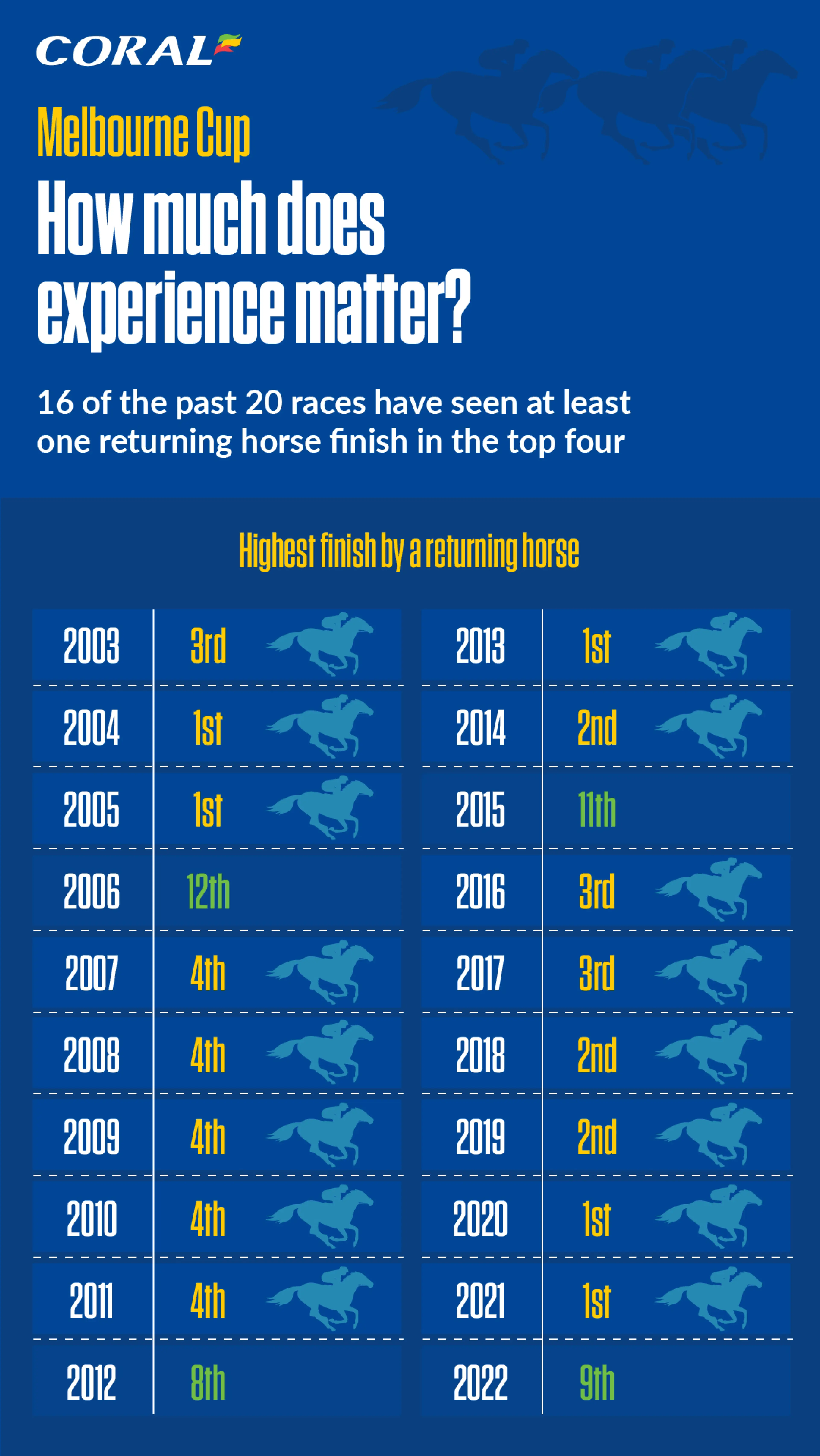Melbourne Cup trends: The key numbers from the last 20 years
Published:
The Melbourne Cup is one of the most prestigious flat races in the world and is known in Australia as the ‘race that stops the nation’.
Founded in 1861, the Melbourne Cup takes place on the first Tuesday of November at Flemington racecourse.
It is a quality handicap open to horses aged three and over, with a typical field consisting of between 20 and 24 competitors from around the world.
We have analysed the last 20 races to identify the key trends ahead of the Melbourne Cup 2023 on November 7.
How does the Melbourne Cup compare to other major flat races?
The Melbourne Cup is one of the longest premier flat races in the world. It was originally run over two miles (3,219m), before being shortened slightly to 3,200m in 1972 when Australia adopted the metric system.
None of the other major overseas races top a mile-and-a-half, with the Arc and the Irish Derby both coming in around 2,400m and the Kentucky Derby, Breeders’ Cup Classic and the Dubai World Cup all measuring 2km.
Meanwhile – at 1 mile, 6 furlongs and 115 yards (2,921m) – the St Leger is the longest of the five British Classics.

With 22 starters in 2022, the Melbourne Cup also has a larger field than the vast majority of Group One flat races.
The largest start list among the aforementioned events was at Newmarket’s 2000 Guineas – which had 20 competitors in 2023 – followed by the Kentucky Derby which was contested by 18 horses.
Is the Melbourne Cup difficult to predict?
A combination of a long course and a big field makes the Melbourne Cup a wide-open race. Only three of the last 20 renewals have seen the favourite triumph and two of those were won by the record three-time winner Makybe Diva in 2004 and 2005.
There have been 12 winners in that period who were priced in double digits before the race, four of which were rated at 20/1 or longer including the 100/1 outsider Prince of Penzance who denied Frankie Dettori an elusive Melbourne Cup victory in 2015.

The unlikely win by Prince of Penzance remains the exception rather than the rule though. Only five of the 152 horses with starting Melbourne Cup odds of 50/1 or longer since 2003 have managed to finish in the top four.
There has been far more value to be had in the mid-priced runners, with 10 wins and 30 further top-four finishes by horses priced between 17/2 and 25/1.
Who has the best record at the Melbourne Cup?
Such is the competitiveness of the Melbourne Cup, even the best jockeys and trainers finish outside the top four more often than they place.
Three-time winner Kerrin McEvoy is the most successful active rider in the last 20 years, having enjoyed two victories and four further top-four finishes in 17 starts during that period.
New Zealand’s James McDonald and Australians Brett Prebble and Craig Williams have one victory apiece to go with multiple top-four finishes, while Frankie Dettori – who has recently reversed his decision to retire at the end of the year – is yet to win the Melbourne Cup in 17 attempts (nine of which have come since 2003).

Meanwhile, Irish trainers have an excellent recent record at Flemington, with Willie Mullins, Joseph Patrick O’Brien and Aidan O’Brien ranking one, two and three for highest top-four percentage in the last 20 races.
That said, only the junior O’Brien has topped the rostrum, first with Rekindling in 2017 and then with Twilight Payment in 2020.
How much does experience matter in the Melbourne Cup?
Twilight Payment – who finished 11th in 2019 – is one of five returning winners across the last two decades.
Makybe Diva won in 2003 as a first timer before repeating the feat in 2004 and 2005, while Fiorente (2013) and Verry Elleegant (2021) improved on second and seventh place showings in the previous year, respectively.

Overall, 16 of the last 20 years have seen at least one horse finish in the top four having run the race previously.
This bodes well for 2022 winner Gold Trip, who warmed up for this year’s race by winning the Turnbull Stakes at the same venue. The six-year-old French thoroughbred is bidding to become only the sixth horse in the Melbourne Cup’s 162-year history to win on more than occasion.
Which starting barrier provides the most Melbourne Cup winners?
The build-up to the Melbourne Cup starts at the beginning of race week, specifically when starting barriers are drawn on Saturday.
Last year Gold Trip became the fifth winner to jump from barrier 13, with only gates five, 10, 11, 14 and 19 having provided more champions since barriers were first introduced in 1924.
Barrier five is the most successful in Melbourne Cup history with eight winners including two back-to-back in 2012 (Green Moon) and 2013 (Fiorente).

All 24 barriers have seen at least one victory in the previous 98 years, with numbers 15 and 18 being the only gates that are yet to produce multiple winners.
Barrier 18 broke its duck in 2021 with Verry Elleegant, but gate 15 is in the midst of a 51-year drought since Silver Knight’s victory in 1971.
View the latest horse racing odds









